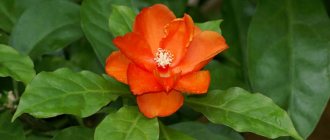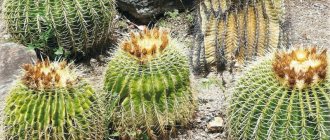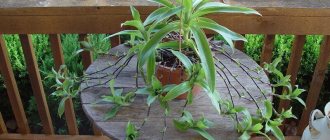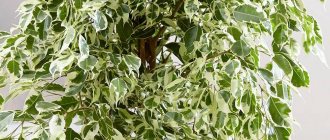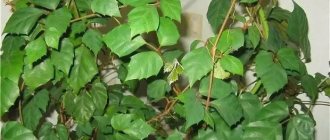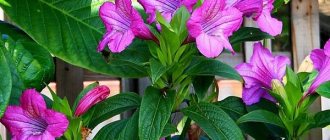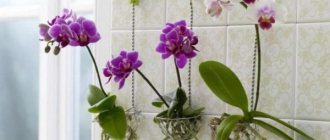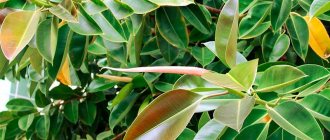What does chrysalidocarpus look like, what family does it belong to?
Chrysalidocarpus was brought from distant Madagascar; the Comoros Islands are also considered to be its homeland. Belongs to the Arecaceae family, of which there are more than 2.5 thousand species. This palm tree is very moisture-loving, and it tries to extract water not only from the soil, but also from the air.
Chrysalidocarpus areca can grow up to 3 meters
As for the structure, there are plants that look like a bush, since there is strong branching at the base. There are also single-barreled representatives.
In its natural environment, a palm tree can reach 10 meters in height; in a year it grows only 30 cm, but it gains mass in width due to the appearance of lateral shoots.
This is interesting! Many owners of this tropical crop claim that chrysalidocarpus is able to take away negative energy in the house and give out positive energy.
Growing conditions and care
The areca palm is a large ornamental plant. You can’t put it on the windowsill: chrysalidocarpus needs space to grow. Growing up in the tropical jungle, areca also imposes special conditions on its maintenance. Caring for it at home will force you to strictly adhere to the humidity and lighting parameters.
Location and lighting
When purchasing a small areca from the store, remember that it can grow up to 3 meters, which means it needs a lot of space. This plant is not suitable for small rooms; it is difficult to provide it with decent conditions.
A spacious hall with good lighting is what this tropical guest needs. It is for this reason that it is used to decorate offices, foyers and the interiors of other large areas.
If the size of your home allows you to contain such a large plant, then find a place for it with diffused lighting. Remember that palm leaves also grow in length; choose a place with a view of the lush crown of the plant. For proper lighting (the key to proper development), the palm tree should be rotated once a week.
Advice! If possible, place the palm tree near the east window in summer, and move it to the south window in winter.
Temperature
Born in the tropics, areca easily tolerates high temperatures (up to 32 °C), but for indoor keeping 22...24 °C are optimal. The lower temperature limit that the plant can withstand is 16 °C.
In winter, when cold air can penetrate into the room, the palm tree should be protected from drafts. You should not place it near operating heating devices: too dry air is contraindicated for it.
Air humidity
High humidity is a natural background for a plant, and it is advisable to provide it with the same level at home. The areca flower thrives when the air humidity in the room is 60–70%. To maintain these parameters, the palm tree should be sprayed regularly. You can help her by installing a humidifier, or placing a container of water next to the tub.
The soil
Palm trees have such special requirements for the composition of the soil that experts recommend enriching even store-bought soil for palm trees with charcoal, peat, and bone meal.
If the substrate is prepared independently, then for it you need to take: 1 part each of leaf soil and charcoal, 2 parts of turf soil, ½ part each of humus and coarse river sand. As an enricher, 1/10 of bone meal and 1 part of pumice or slag are added to the soil.
Transfer
It is best to transplant in April. To move the plant to a new pot, use the transfer method, after moistening the soil.
Before putting the roots into the pot, they are carefully inspected, and any obviously rotten or damaged ones are carefully removed. Places of cuts are sprinkled with charcoal
Place the roots so that they are in the center of the flowerpot. Fill the space between the roots and the walls of the pot with soil, lightly press down, and water.
Important! After replanting the plant, remove it from direct sunlight for a week.
Watering and fertilizing
Areca does not need frequent and abundant watering. It is correct to moisten the soil when it has dried a few centimeters. When the soil becomes waterlogged, the roots of the palm tree do not have time to absorb all the water and rot.
Considering the negative reaction of the plant to the chlorine contained in the water, the liquid must be left to settle for 1–2 days. Experienced gardeners stock up on rainwater
It is important to always drain any water that has leaked into the pan.
The main feeding work is carried out from April to August. The frequency of fertilizer application is once every 2 weeks. For areca, special complexes for palm trees are taken. From time to time it is useful to spray the plant with liquid nutrient solutions.
Main types of chrysalidocarpus
Areca palm chrysalidocarpus - home care
There are about 20 species of chrysalidocarpus palm, but not all varieties are suitable for home cultivation. In an apartment, the tropical crop grows up to 3 meters. Each variety has its own structure; there are plants with one trunk, and others with several stems.
Chrysalidocarpus lutescens
This representative is also known as Chrysalidocarpus dipsis, Chrysalidocarpus lutescens. The palm tree stands out from the rest of the tropical vegetation with its yellow-orange stems, which branch very densely at the base. The foliage is colored the same color as the shoots. The fronds grow up to 2 m in length and one in width.
Chrysalidocarpus yellowish
The dark scales on the petioles disappear as the Tropican grows older. In the natural environment, yellowish fruits can form on a palm tree of this variety, but in home floriculture the berries can be found extremely rarely.
For reference! Caring for chrysalidocarpus yellowish at home includes general procedures: watering, fertilizing and replanting. This palm tree does not require any special measures.
Chrysalidocarpus madagascariensis
A single-trunk evergreen palm tree, which reaches about 30 cm in diameter. Rings are well drawn on the trunk. An adult plant can reach 8 m in height.
The leaf blade of chrysalidocarpus is smooth, its length varies within 45 cm, and its width is 2-3 cm. Branched inflorescences are located in the leaf axils.
As for the living conditions, tropical crops prefer a warm climate, but cold can negatively affect its growth and development.
Chrysalidocarpus madagascarensis
Popular types
There are 8 species of plants classified in the genus Chrysalidocarpus. The two most popular types of chrysalidocarpus that can be found in stores are:
- Chrysalidocarpus yellowish (Ch. lutescens Wendl). Synonym: Diptis yellowish. There is a name Chrysalidocarpus lutescens. From one base grows 2-5 yellowish trunks strewn with small black dots. Leaf petiole up to 60 cm, yellow, grooved.
- Madagascar (Ch. madagascariensis). Synonym – Diptis Madagascar. Smooth, slightly widened below trunk, with pronounced rings. The leaves are pinnate, with a glossy surface, the leaves are arranged in a bunch.
You can learn more about the most common types of palm trees, as well as see photos of the plant here.
This video talks about the Chrysalidocarpus yellowish palm tree.
Features of caring for chrysalidocarpus at home
Before you start a tropical plant, you need to figure out what kind of care Chrysalidocarpus requires at home. What exactly does a palm tree need for normal growth and development?
Temperature and lighting
Hamedorea palm - home care
This representative of the arecaceae loves bright light, so it is recommended to place a flowerpot with a palm tree on a south or south-east window sill. In addition, the plant must be provided with long daylight hours, it must be at least 12 hours. In winter you will have to install additional lighting.
In order for indoor plants to develop well and the crown to be symmetrical, it is necessary to periodically turn the pot over.
It is also necessary to maintain the temperature regime, the indicators should be as follows:
- summer - 22-25 degrees;
- winter - 18-22 degrees.
In addition, you need to periodically ventilate your home, but there should be no drafts, this can affect the health of the indoor palm tree.
Watering and humidity
Chrysalidocarpus loves a humid climate, this must be taken into account when growing. The bush needs to be sprayed regularly, this is especially important in the summer. The water should be well settled, soft and not very cold.
Attention! Once every two weeks, give the plant a shower or wipe the leaves with a damp cloth.
The substrate should be watered generously and ensure that it is always moist. Otherwise, the plant will begin to dry out and the leaves will curl and fall off. In winter, watering activities must be approached carefully, avoiding overwatering, as this can harm the roots.
Soil preparation and feeding features
Chrysalidocarpus places special demands on the quality of the substrate; the plant needs fertile and light soil with a neutral reaction. But alkaline soils are not suitable for it. For replanting, you can purchase ready-made compounds that are intended for palm trees. You can also make the mixture yourself; for this you need to prepare:
- leaf soil;
- humus;
- coarse sand;
- peat;
- turf.
As for feeding, areca is fertilized throughout the year. In spring and summer, specialized complexes or universal mineral fertilizers are applied. The procedure is carried out twice a month. In winter, feed once a month.
Mr. Summer Resident advises: possible difficulties when caring for chrysalidocarpus and their solution
If a plant grows poorly or gets sick, it needs fertilizing, a certain watering regime, and proper lighting.
| Problem | Signs | Elimination methods |
| Nitrogen deficiency | The leaves are first light green, then yellow, and the plant stops growing. | Use nitrate (ammonium, sodium), ammophos, urea. |
| Potassium deficiency | Yellow, orange spots on old leaves, necrosis of the edges appears, the leaf dries out. | Feed with potassium sulfate and wood ash. |
| Magnesium deficiency | Light, wide stripes along the edges. | Fertilize with magnesium sulfate and potassium magnesium. |
| Manganese deficiency | New leaves are weak, with necrotic stripes, and small in size. | Use manganese sulfate. |
| Zinc deficiency | Necrotic spots, leaves are weak and small. | Use zinc sulfate or zinc-containing fertilizers. |
| Dry, cold air, insufficient watering | Brown spots on the tips of leaves. | Increase the temperature, humidity, water more abundantly. |
| Too much sun or too little moisture | The leaf blade turns yellow. | Shade, when it is too hot, water more often. |
| Brown leaf spot | Watering with hard water, waterlogging, low temperature. | Adjust watering, temperature according to the season, and settle the water. |
| The lower leaves darken and die | Abundant watering. The leaves were torn off by hand. | Cut the plates with sharp scissors. |
| Brown plate tips | Cold, dry air, lack of moisture. | Raise the temperature, moisten, water more often. |
Install drainage so that water flows into the pan immediately after watering.
To know that it is time to water, pierce the ground with a sushi stick. When it is slightly damp, you can water it; the soil sticks - it’s not time yet.
When and how does it bloom, flowering periods
The palm tree begins to bloom in late May. Paniculate inflorescences of a yellow hue appear in the leaf axil. Although in an apartment you may not be able to wait for it.
Areca flowers bloom with small yellow flowers
After the buds wither, berries are formed in their place, and seeds are obtained from them for further propagation.
Attention! You must be extremely careful with the fruits of the areca palm, as they are very poisonous. It is best to use gloves if you plan to come into contact with the berries.
Description of culture
Areca palm - home care and propagation
Among the 50 species of areca that exist in nature, there are miniature bushes up to 35 cm in height, and real giants - trees reaching 20 meters in height.
According to plant classification, areca is a tree with one or more tubular stems. The stems end in lush foliage, forming a kind of comb. The leaf blades are painted in rich shades of green. Originally dissected, they look like feathers.
In nature, the palm tree blooms by shooting out cob-shaped inflorescences containing small white male and female flowers. After flowering, the areca produces red-orange fruits with horn-shaped seeds.
The external similarity of some Areca palms confuses beginners who find it difficult to distinguish true chrysalidocarpus from the same Hamedorea elegans. If you have chrysalidocarpus and chamedorea in front of you, their differences are simple:
- Number of leaf segments: areca has 4–6 blades, chamedorea has more.
- Inflorescence shape: chamedorea has a loose panicle, areca has a dense ear.
- Areca is significantly taller than Hamedorea.
How does a palm tree reproduce?
Areca reproduces well, so you can carry out the procedure yourself. Root suckers are most often used; they take root faster. Using seeds you can also get a young palm tree, but you will have to spend time and effort.
Propagation by seeds
Most often, gardeners try to grow the chrysalidocarpus lutescens variety from seeds. True, this is a long process and not always justified, since the germination of planting material is average. Planting is carried out in several stages, namely:
- soak the seeds in warm water;
- placed on the surface of a nutrient substrate, which is pre-moistened;
- cover the container with plastic wrap;
- Before emergence, spray and ventilate.
Transplantation of seedlings into a separate pot is carried out after two adult leaves are formed on the seedling.
Attention! When propagating a palm tree from seed, it is worth sowing several seeds at once, this will significantly increase the chances of getting a new plant.
Reproduction by root shoots
If the vegetative method is used, it is carried out in early spring. Babies can only be obtained from an adult flower; the shoots should be cut using a sharp knife, making an oblique cut. After this, you need to sprinkle the wound with coal.
The resulting shoot is placed in previously prepared soil, moistened and removed in partial shade. Additionally, cover with a plastic cup, it will create a greenhouse effect. You also need to monitor the temperature; the indicator should not rise above 29 degrees and fall below 26.
Interesting! The chrysalidocarpus flower has a peculiarity - female buds bloom in the lower part of the plant, and male buds form at the very top.
The easiest way to propagate chrysalidocarpus is by root shoots
Features of growing palm trees
The most suitable conditions for growing areca chrysalidocarpus in an apartment are a place where diffused sunlight will predominate. You can place the pot with the plant in a sunny place, but only in the summer and not for long. When burns appear on the foliage, it is better to move the plant to another location.
When the areca palm reaches the age of six years, it becomes more resistant to the negative effects of direct rays of the sun; if there are burns, the flower can be revived. With proper care of the planting in an apartment, you can achieve stable and rapid growth of deciduous feathers, the crown will be strong and beautiful, and the appearance of the flower will be healthy.
It will take some effort to ensure that the inflorescences appear evenly. Sunlight should hit all sides of the flower so it will bloom evenly. To do this, the pot with the plant must be rotated regularly so that the sun hits different sides of it every week.
Replanting a plant when purchasing or planting
Areca chrysum is extremely difficult to tolerate transplantation, so the procedure is carried out only in extreme cases. There is no need to disturb the plant again.
An adult bush is replanted no more than once every 4 years, at which time the flowerpot is changed. The palm tree is removed by transshipment; this is done with special care so as not to damage the roots.
Large palm trees growing in tubs have their topsoil renewed annually. This will be quite enough. A newly acquired plant also does not require replanting; it will already experience severe stress due to a change of location; there is no need to complicate the situation.
Botanical description
Chrysalidocarpus belongs to the Arecaceae family. It grows naturally in the Comoros and Madagascar.
Translated from ancient Greek, “chrysalidocarpus” is translated as “golden fruit”: chryseus - “golden”, karpos - “fruit”. Its stems, indeed, have a noticeable yellowish tint. The second, outdated name is areca. The name butterfly palm has caught on among the people.
Chrysalidocarpus can be either a single-stemmed or multi-stemmed palm , growing in a bush form (monoecious or dioecious).
The stems are smooth or covered with light fluff; they can be swollen at the locations of the rings. Often lateral shoots emerge from the trunks, which together represent a group.
The leaf blades are pinnate, lanceolate, dissected at the ends. They grow in pairs, 40-60 pairs each, denser in the upper part, on thin cuttings. In some species, the leaves grow near the stem itself and, merging with the general crown, they create the effect of a lush cloud, which looks very beautiful. The color of the leaves is bright green, with small black dots.
Possible problems during cultivation
Chrysalidocarpus rarely gets sick if you care for it properly. It is also important to provide the flower with conditions close to its natural habitat.
Leaf tips may dry out due to insufficient moisture
Leaves are drying
This problem can occur due to too dry air in the room where the flowerpot is located. You should ventilate the room more often and spray the foliage.
Also, the ends can dry out due to insufficient moisture or, conversely, its excess. It is worth monitoring the condition of the soil.
Often the foliage dries out and darkens due to non-compliance with temperature requirements.
Attention! In winter, it is necessary to remove the flowerpot from the heating radiators. If this is not possible, then place a bucket of water next to it.
Diseases and pests
As a result of excessive waterlogging, the palm tree may develop bacterial rot or fungal infections.
Roundish brown spots with a lighter rim appear on the leaves. To combat such diseases, spraying with fungicidal preparations is used.
In cultivation, chrysalidocarpus can be attacked by the following insect pests:
- spider mite;
- scale insects;
- whitefly;
- thrips.
To combat them, various insecticidal and acaricidal preparations for indoor flowers are used (Aktellik, Aktara, Decis, etc.).
A palm borer has been spotted on the Black Sea coast, causing great damage to palm crops. But no cases of infection with it have yet been found in indoor conditions.
Leaves are drying
If the level of humidity is insufficient, areca leaves dry out. You need to spray the plant more often and place bowls of water near it.
It's even better to use a humidifier. If after taking appropriate measures the problem does not disappear, then the reason lies in insufficient nutrition.
The composition of fertilizers should be reviewed. If brown spots and black dots appear on the tips of the leaves, this may indicate an excess amount of fluoride and excessive fertilizing.
If it turns yellow
The appearance of clear yellow or brownish spots on the leaves in summer is a symptom of a sunburn on the flower.
It is necessary to move the palm tree to a less lit place. Yellowing tips of leaves indicate insufficient moisture or low temperature in the room.
Chrysalidocarpus propagation
Naturally, during the period of growing chrysalidocarpus, there is a desire to propagate this wonderful plant. You can do this in two ways:
- seeds;
- basal shoots.
If caring for the areca chrysalidocarpus palm at home is not so difficult, then in order to reproduce its exotic beauty you will have to work a little. Adherents of the first method buy or otherwise obtain seeds and soak them for 3-4 days in a special solution of sulfuric acid. If you don’t have it on hand, you can use regular water, just to keep it warm. After soaking, the planting material is sent to a substrate suitable for palm trees, which must be carefully watered, or better yet, sprayed.
The optimal temperature for seed germination is 25-30 degrees Celsius. If the room is cooler, the germination of the grains will be delayed. Like adult plants, small seedlings love light and high humidity. Soon the first leaves appear. After this, the chrysalidocarpus can be transplanted into separate pots and in a few months, with proper care, they will turn into full-fledged plants.
Many gardeners also practice vegetative propagation. It can be produced at any time of the year, but it is best in spring or summer, when the weather is warm. Strong sprouts filled with juice are selected and carefully cut off at the very base of the plant. Initially, they should already have mini-roots, which, after transplanting into the ground, gain strength and slowly turn into a full-fledged root system. The main thing is that the soil is moist and the room is warm. As practice shows, propagation in this way is easy even for beginners in floriculture.
Kinds
This houseplant has two main varieties: yellowish and Madagascar.
The yellowish species of Chrysalidocarpus is a bushy palm. The plant has several smooth trunks without branches, but with beautiful feather-shaped leaves. With age, scales appear on the petioles in place of the spots that are visible on young plants. If this type of palm tree was purchased in a store and several shoots are visible in the pot at once, there is no need to dig up and replant them separately. This plant likes to grow this way, in a family. If even one shoot is dug up, the entire plant may die.
The Madagascar species of areca is a single-stemmed palm tree. Under natural conditions this is a tree. Chrysalidocarpus of this type is a classic palm in outline. At its base, the trunk is slightly widened, and then it gradually narrows. Its diameter at the apex can be up to 20 mm. Ring marks from fallen old leaves are clearly visible on the trunk. The leaves are arranged in bunches on the palm tree.
Location of chrysalidocarpus indoors
Since chrysalidocarpus is a southern plant, it is not afraid of the sun. But still, exposure to excessively active sunlight in the period from 11 to 15 days is not advisable.
This is in the summer when the sun is at its most active. By the way, the plant also feels good in partial shade. But he will need time to adapt to such lighting.
in the lighting of chrysalidocarpus that you should be aware of: once a week the flower should be rotated 180 degrees. Then the palm leaves will grow symmetrically.
If you do not do this , the plant will turn out one-sided. That is, leaves on the sunny side will grow much more actively than on the shady side.
The temperature of a palm tree is exactly the same as that of people: 18-23 degrees. It is at this temperature that the plant (like a person) feels most comfortable. But in summer, ideally the temperature should be raised to 25 degrees. This is exactly what happens in the tropics of Madagascar.
In order for the plant to fully develop, it requires a constant flow of fresh air. Just without drafts: chrysalidocarpus does not like drafts. Air humidity should be high.
Read with us about useful indoor plants.
Hydrangea paniculata requires knowledge about proper planting. Note to the gardener.
Chrysalidocarpus dries out: why and what to do?
Chrysalidocarpus leaves dry out what to do
The butterfly palm is a chic decorative flowerpot that does not require special care in good light and air humidity. But difficulties cannot be avoided.
Chrysalidocarpus leaf tips dry out
Drying leaves, tips, edges are the most common problems. The first reason is lack of humidity (dry air and substrate). As well as low temperature and mechanical damage. In case of such problems, you need to increase the number of sprays of the plant, remove it from the battery, and place a container with water nearby.
Chrysalidocarpus leaves turn yellow and die
The tips of the leaves can not only turn yellow, but also turn brown and then die. The reason may be an excess of fertilizer that contains fluorine and superphosphates.
The leaves become covered with brown spots if a full bouquet of unfavorable conditions is collected: a sharp change in temperature, water for irrigation is too hard or taken from the tap. If the leaves have darkened completely, this is a signal of rotting. Watering must be stopped immediately.
Yellow-brown spots will indicate that the plant has received a sunburn. The palm tree urgently needs to be moved to partial shade. The second sign of excess lighting is the curling of the sheet and the appearance of straw spots on it.
Growing Chrysalidocarpus
Despite the tropical origin of this culture, it is not whimsical and demanding in content. A mandatory requirement when caring for chrysalidocarpus at home is a warm place where it will be grown and good lighting.
Location. This, as already noted, is a light-loving plant, so it should be placed on southern windows. The palm tree does not like direct sun, preferring diffused light. In summer, shading is required, especially if we are talking about a young individual. Adult chrysolidocarpus arecas are not so demanding to care for; at home they can be kept in partial shade, but away from drafts. Overheating and drafts are the main negative factors for tropical crops; they should be completely eliminated so as not to harm the health of the plant.
Temperature. The most comfortable temperature for areca is 20 – 28 degrees. The year-round temperature should be even, in winter not lower than 16-18 degrees. At lower temperatures, the palm tree will not die, but its growth will stop. An influx of fresh air is beneficial for her. In summer you can keep it in the garden.
Air humidity and watering. When caring for areca chrysalidocarpus, it is necessary to create high air humidity, since it is a plant of the tropics. It is best to place the pot with it on a tray with pebbles filled with water. It responds well to spraying. The leaves should be washed with water at least twice a month. It is useful to cover the root collar with moss. In summer, watering is plentiful, in winter - limited. Does not tolerate drying out of the earthen clod.
Substrate and feeding. Areca needs loose and nutritious soil; for its successful growth and development, fertilizers will need to be applied throughout the year. From March to August, fertilizing is applied 2 times a month. From September to February – once a month. Fertilizers for decorative deciduous plants or mineral fertilizers for palm trees are suitable for growing this crop.
Special soil for palm trees from the store will also work.
Transfer. The chrysalidocarpus flower is difficult to replant, so it should be done only as a last resort, using the transshipment method with replacing the drainage layer and adding fresh soil. Young, rapidly developing individuals require annual transplantation. It is enough to replant an adult palm tree every 3 years. Many gardeners, instead of reloading, change the top layer of soil in the pot with the addition of a good layer of drainage.
How to replant chrysalidocarpus
This palm tree has a fairly powerful root system, so the young plant must be replanted annually. Chrysalidocarpus tolerates this procedure quite painfully. Therefore, it is best to replant by transferring the plant, when the drainage in the pot is replaced and soil is added. Adult specimens need to be replanted no more than once every 3 years. The optimal period is March-April.
It is better to purchase a deep pot in which chrysalidocarpus will feel comfortable. Care involves high demands on the soil mixture in which the palm tree will be grown. Its drainage qualities are very important. Stagnation of moisture is detrimental to the plant, so the optimal composition would be a mixture of pumice, pine bark, pebbles, peat, humus, and charcoal. A ready-made substrate for growing palm trees from a flower shop is also suitable.
Reproduction
Chrysalidocarpus, when propagated at home, reproduces by seeds and root shoots. Vegetative division of the root system occurs regardless of the time of year. The shoots are located next to the main stem. You should not use root suckers less than 30 cm in height for propagation - the plant will suffer for a long time. To transplant a suitable shoot, it is necessary to separate it from the mother root with a sharp knife, while being careful not to damage the main trunk. All leaves must be removed from the new shoot, and the cut area on the main plant must be dried for two days, treated with a fungicide.
The root system of the offspring must first also be treated with an antibacterial drug, and then with a root formation stimulator. For rooting, the cuttings are planted in a substrate of coarse perlite or sand. The optimal temperature for good rooting and growth of the plant is 27-29 C. It is better to keep the pot in partial shade. The rooting period is about three months. After the plant begins to grow green mass, it can be transplanted into soil mixture for palm trees.
You can grow a palm tree from seeds. Chrysalidocarpus, which is not difficult to care for at home, will require more patience in this case. First, soak the seeds for a couple of days in warm water. After this, they are ready for planting in a light soil mixture. Shoots will appear no earlier than after 12-16 weeks, subject to temperature, humidity and lighting conditions. The optimal temperature for seedlings is 20-25 degrees. The pot with seedlings should be well lit. You can replant a young palm tree after the first leaf has formed.
For development and spectacular appearance, the palm tree will need feeding. In addition, a strong plant will be more resistant to diseases. For these purposes, regular fertilizer for indoor flowers or mineral fertilizer for decorative deciduous plants is suitable. Feeding is carried out from late spring to early autumn with a frequency of once every two weeks.
